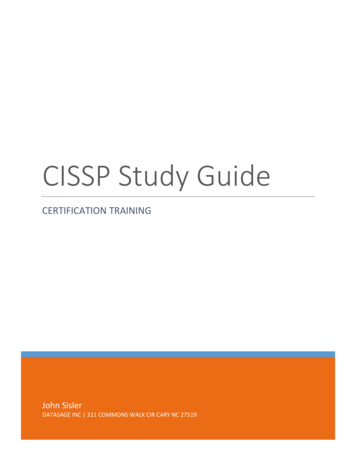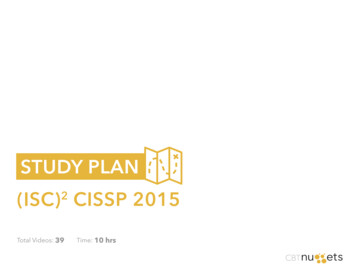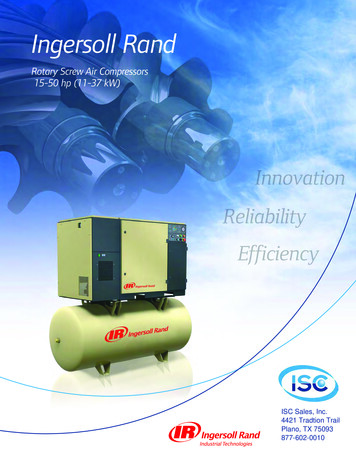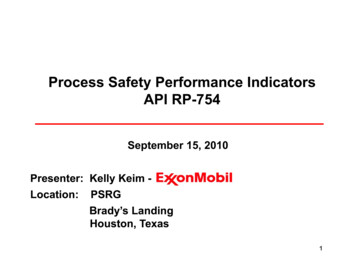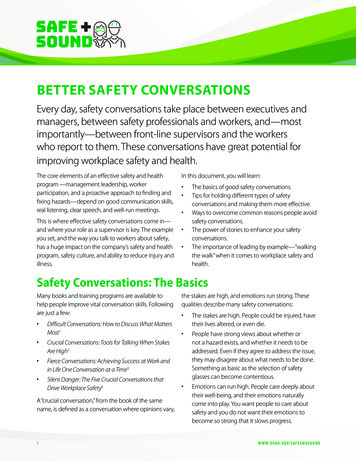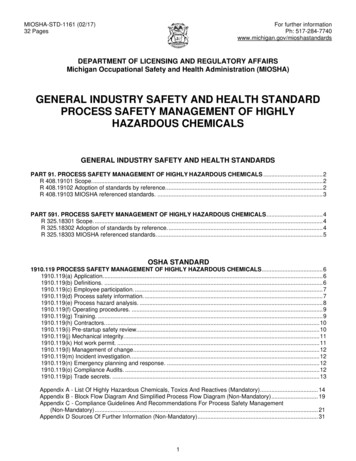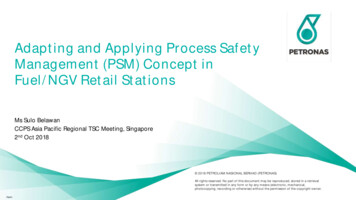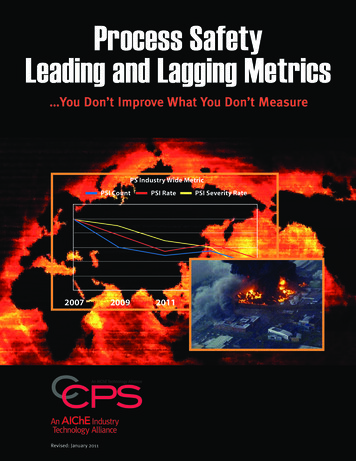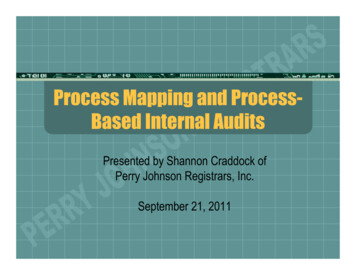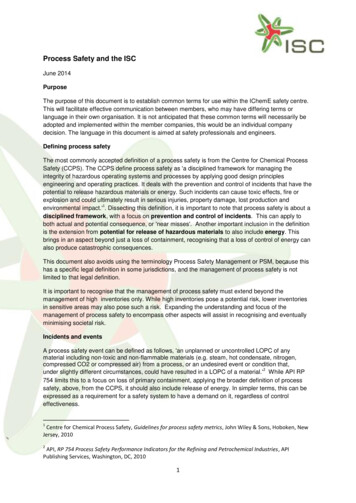
Transcription
Process Safety and the ISCJune 2014PurposeThe purpose of this document is to establish common terms for use within the IChemE safety centre.This will facilitate effective communication between members, who may have differing terms orlanguage in their own organisation. It is not anticipated that these common terms will necessarily beadopted and implemented within the member companies, this would be an individual companydecision. The language in this document is aimed at safety professionals and engineers.Defining process safetyThe most commonly accepted definition of a process safety is from the Centre for Chemical ProcessSafety (CCPS). The CCPS define process safety as 'a disciplined framework for managing theintegrity of hazardous operating systems and processes by applying good design principlesengineering and operating practices. It deals with the prevention and control of incidents that have thepotential to release hazardous materials or energy. Such incidents can cause toxic effects, fire orexplosion and could ultimately result in serious injuries, property damage, lost production and1environmental impact.' . Dissecting this definition, it is important to note that process safety is about adisciplined framework, with a focus on prevention and control of incidents. This can apply toboth actual and potential consequence, or 'near misses'. Another important inclusion in the definitionis the extension from potential for release of hazardous materials to also include energy. Thisbrings in an aspect beyond just a loss of containment, recognising that a loss of control of energy canalso produce catastrophic consequences.This document also avoids using the terminology Process Safety Management or PSM, because thishas a specific legal definition in some jurisdictions, and the management of process safety is notlimited to that legal definition.It is important to recognise that the management of process safety must extend beyond themanagement of high inventories only. While high inventories pose a potential risk, lower inventoriesin sensitive areas may also pose such a risk. Expanding the understanding and focus of themanagement of process safety to encompass other aspects will assist in recognising and eventuallyminimising societal risk.Incidents and eventsA process safety event can be defined as follows, 'an unplanned or uncontrolled LOPC of anymaterial including non-toxic and non-flammable materials (e.g. steam, hot condensate, nitrogen,compressed CO2 or compressed air) from a process, or an undesired event or condition that,2under slightly different circumstances, could have resulted in a LOPC of a material.' While API RP754 limits this to a focus on loss of primary containment, applying the broader definition of processsafety, above, from the CCPS, it should also include release of energy. In simpler terms, this can beexpressed as a requirement for a safety system to have a demand on it, regardless of controleffectiveness.1Centre for Chemical Process Safety, Guidelines for process safety metrics, John Wiley & Sons, Hoboken, NewJersey, 20102API, RP 754 Process Safety Performance Indicators for the Refining and Petrochemical Industries, APIPublishing Services, Washington, DC, 20101
An incident is an event where an actual consequence is realised. This may be an actual loss ofcontrol, such as a leak or fire. API RP 754 utilises a tiered ranking, to differentiate consequences.At any facility, there are many more instances of potential consequences rather than actualconsequences. Acknowledging and analysing these provides for an opportunity to learn from thenear miss, rather than have the consequence realised at some future time.The management of process safety - maintaining controlBased on the management of process safety being about having a disciplined framework focused onpreventing and control of process safety events, control needs to be maintained at all phases of afacility lifecycle, and therefore management of process safety applies from initial concept orexploration phase right through to decommissioning or abandonment.The ISC considers that process safety is fundamentally built on six functional areas or pillars. Theseare: knowledge and competence (KC)engineering and design (ED)systems and procedures (SP)assurance (AU)human factors (HF)culture (CU)These areas break down aspects of an organisation's business, within each system for leadership,management and action. For complete management of process safety, it is vital to ensure there ishigh level leadership and commitment across all 6 functional areas.Leadership in knowledge and competence in process safety is fundamental. This underpinsinherently safer engineering and design and robust safety systems supporting the upholding andcontinued evolution of systems and procedures for maintaining safer process operations. These aresustained by the best practice in the assurance of process safety in a changing environment takingfull account of the contribution of human factors, behaviours and external influences. Theseelements collectively shape the prevailing culture in the workplace and in society at large in order tobuild a common understanding of risk issues and to develop and utilise new ways for cost effectiveand sustainable risk reduction in the process industries.The ISC frameworkThe ISC framework of six functional areas is shown in Figure 1. It defines each significant phase of afacility life cycle, from initial idea or exploration to eventual decommissioning, plotted against the sixfunctional areas. It should be noted that 'operation', 'maintenance' and 'ongoing integrity' have beengrouped together because they are a continuous loop in an operating facility.The lifecycle commences with 'leadership', as this underpins every functional area, as well as alldecisions and activities within an organisation. The overarching phases of design, construction,operation, maintenance and ongoing integrity and decommissioning or abandonment apply to allmanner of facilities and activities, including, but not limited to plant, pipelines, wells and drilling.Within these functional areas, typical examples have been included to explain their application in eachphase. This list is not exhaustive; it just serves to give context in each phase. The framework2
documented from the functional areas is also used to provide a common platform for IChemE SafetyCentre members to communicate, plan and make decisions.This framework focuses on leadership within the organisation and how it interacts with day to daymanagement. It does not explain the corporate governance of an organisation, though the frameworkhas been mapped to Corporate governance for process safety - guidance for senior leaders in high3hazard industries .This simplification of management of process safety is done in an effort to make the conceptsaccessible to a wide audience. It serves as a road map to show basic concepts and their application.It is not intended to diminish the technical aspects of process safety or risk management.Specific terms used in this framework, including the six functional areas have been defined inappendix 1, common terms.There are several other frameworks or models for process safety, namely the CCPS, the EnergyInstitute (EI) and the Organisation for Economic Co-operation and Development (OECD). Theseframeworks focus on high level system management principles, and can be applied as a managementsystem in an organisation. To aid organisations in understanding and applying the six areas, thethree frameworks have been cross referenced with the six functional areas. This cross reference isfound in appendix 2. The cross referencing is illustrative only and not exhaustive, otherinterpretations are possible. This work seeks not to create another framework to choose from, but toprovide practical guidance in each of the six areas, to assist organisation to improve the managementof process safety, assuming they already have a management system in place.3OECD, Corporate governance for process safety - guidance for senior leaders in high hazard industries, OECDEnvironment Health and Safety Chemical Accidents Program, 20123
Figure 1 ISC process safety frameworkNote: these examples are illustrative only, not exhaustive.phases of afacilityleadershipdesignconstructionoperation, maintenance andongoing integritydecommissioning orabandonmentknowledge andcompetencedemonstrated importance ofknowledge and competence inan organisation, sufficientlyresourceddesign engineers, operationsspecialists inc drillers, scientists,other HSSE disciplines, otherengineering disciplinesconstruction supervisors,trades, drillers, engineers,inspectors, commissioningteams, transfer of knowledge toeventual operating teamsoperations, drilling,maintenance and st contractors, includinginspection, engineeringtechnical authorities andsupport, operational andprocess technical authoritiesand support, creating anawareness of process safetyrisk among senior managers,refresher training for all,inspection technical authoritiesand supporttrades, engineers inc drillers,supervisors/managers, specialistcontractors, environmentaldisposal specialists, emergencyresponse and clean upengineeringand designsystems andproceduresrobust and practicalmanagement systems in placeand followed by all, sufficientresources engaged to maintainsystemsrobust engineering decisionssupported, emphasis put onproving systems are safe, ratherthan unsafelocation and siting, inherentlysafer design, hazard and riskassessment, engineered safetysystems, material specification,safety critical elementsincluding ability to test,management of change,interfacing with otherengineering disciplines, lifecycle cost approachdesign hazard management,management of change,preparation of operating andmaintenance procedures,preparation of emergencyproceduresensuring as built constructiondoes not compromise processdesign, material specificationquality assurance, use andremoval of temporary facilitiesfor commissioning, hazard andrisk assessment, managementof changefabrication and testingstandards, safe work systems,quality assurance throughout,system checks, commissioningindividual items of equipment(compressors etc.), trainingoperations and maintenancepersonnelalarm management, includinginspection and testing,management of change,ensuring quality of spares andequipment used for repairsmeets original designspecifications, life extension,management of deviation fromdesign (excursions), ensuringinspection and test methods donot compromise plant integrity,hazard and risk assessment,risk based inspection andmaintenancestandard operating procedures,safe work procedures,deviation and trouble shooting,emergency response drills,operating envelope, hazard andrisk assessment, maintenanceprocedures and methods,inspection and testingprocedures and methods,event investigationstandard operating procedures,safe work procedures,emergency response, hazardand risk assessment, demolitionschedule, environmentalpermits, security procedures,event investigationisolation design, flushing andcleaning facilities, disposal oftoxic materials, returning site tooriginal state, hazard and riskassessment, management ofchange4assuranceassurance processes valued inthe organisation, practice ofquestioning good results andembracing poor results,ensuring processes delvesufficiently deepdesign approvals, safety criticalelements, heath, safety,environment and securityreviews, authority to proceedthrough the various designstages, lessons learntapplication of quality assurancestandards throughout, close outof outstanding action itemsfrom design and construction,pre-start up reviews,mechanical completion andhandover, safety criticalelement testinglead and lag metrics, systemaudits, internal auditprogramme, external processsafety audits, regulatoryinspections/audits,maintenance and inspectionaudits, exchange of bestpractice on maintenance andinspection and testingmethods, inspection of safetycritical elementssite inspections, qualityassurance during demolitionand removal, environmentalclose out of demolition andreturn of site to natural statehuman factorsrecognising that all aspects ofHF have an impact on the safetyof an organisation, sufficientresources and planningimplemented to minimise HFimpactsmotivation and empowermentof the design team, workingwith contractors andconsultants, design taking HMIdesign into accountworkforces with multiplenationalities, cultures andlanguages, event reporting andinvestigation, preventingindustrial disputes, disengagingfinishing trades, fatigue,organisational change andtransition managementwritten procedures, operabilityincluding alarm handling andcontrol room design,maintainability, risk and hazardawareness, longer termmotivation and empowermentof operating and maintenancepersonnel, professionaldevelopment, working withcontractors, consultants,community and regulators,safety critical communications,fatigue, organisational changeand transition managementwritten procedures,constructability, risk and hazardawareness, possible multiplenationalities cultures andlanguages of demolitionworkers, continued motivationof workforce soon to becomeredundant, safety criticalcommunications, fatigue,organisational change andtransition managementculturedemonstrated fair and justculture, people accountable fortheir contribution, andempoweredoperability, working withstakeholders, working withregulators, working outsidenormal jurisdictions, operationsand maintenance personnelengagementworker engagement,understanding hazards andrisks, board and executivedecision making driving cultureworker engagement,understanding hazards andrisks, board and executivedecisions and actions drivingculture, senior managementvisibility, progression up thesafety culture ladderworker engagement,understanding hazards andrisks, board and executivedecisions driving culture, seniormanagement visibility
Appendix 1 - common termsFrameworkleadershipLeadership, and in particular safety leadership, is the art of creating a vision for a group of people andtaking them on a journey to achieve the vision. Leadership is not dependant on authority, meaningsafety leaders in an organisation may not be managers. Leadership is different to management, asSchein states, 'Leaders create and change cultures, while manager and administrators live within4them.'knowledge and competenceKnowledge is the familiarity, general awareness or understanding of the impact of one's actions.Competence means the ability to perform activities and to undertake work functions in accordancewith agreed standards, rules and procedures, and to demonstrate defined behaviours on a regularand consistent basis over time. Competency is a combination of practical and thinking skills,experience and knowledge. Acceptable competency depends on the context and the environment inwhich the activity is performed, and also on the organisation’s working culture. Generally, competency5is the outcome of training both off-the-job and on-the-job.engineering and designEngineering and design is about applying the hierarchy of controls in the design of equipment andsafety systems. This includes the concept of inherently safer design as a starting point. This area alsoincludes design across the entire life cycle of the asset, and the application of robustly engineeredsafety systems.systems and proceduresThis covers the concept of having high level management systems in place, be that safety,maintenance or other management systems, setting a standard to be adhered to.The CCPS defines a management system as 'a formally established set of activities designed to6produce specific results in a consistent manner on a sustainable basis.' This definition encompassesthe intent of the 'systems and procedures' functional area.assuranceAssurance is a define program for the systematic monitoring and evaluation of all aspect of abusiness. This includes tools such as inspection, testing, monitoring, verification and audit. This also4Schein, Edgar, Organisation culture & leadership - 1st ed., Jossey-Bass, San Francisco, CA, 1985APPEA Guide to competency management systems - behaviour and human factors6Centre for Chemical Process Safety, Risk based process safety, John Wiley & Sons, Hoboken, New Jersey, 200755
applies to defining performance standards and metrics for an organisation and reporting performanceagainst them, in addition to the feedback loop, resulting in actions based on data.Assurance should be undertaken at both an internal level in an organisation, such as audit, inspectionand testing, but it must also be undertaken at a governance level by the board. It is important thatboards seek assurance of the processes and operations, rather than reassurance that everything isok.human factorsThe Health and Safety Executive in the United Kingdom define human factors as the interactionbetween the three main factors affecting human performance at work - the job, the individual and the7organisation. This includes consideration of the following; competencehumans and risk assessmentswritten proceduresemergency responsemaintenancesafety culturesafety critical communicationsalarm handling and control room designfatigueorganisational change and transition managementNote that while culture is defined below and stated as a core functional area in this framework, it isalso a subset of human factors. This emphasises the importance and impact of culture across anentire organisation.cultureCulture is a complex concept to understand and positively influence. The work of two noted authorshas been referred to below to explain what is meant by the term 'culture'.In 1985, Edgar Schein first defined culture as:"The pattern of basic assumptions that a group has invented, discovered or developed, to cope withits problems of external adaptation or internal integration, that have worked well and are taught to newmembers as the way to perceive, think, feel and behave."Schein went on to explain how leadership drives culture in 2004 as:'.what they systematically pay attention to. This can mean anything from what they notice and8comment on to what they measure, control, reward, and in other ways deal with systematically.'Dr James Reason postulates that there are five elements to a good safety culture. These are; an9informed culture, a reporting culture, a learning culture, a just culture and a flexible culture.78HSE, HSE human factors briefing note no. 1 - introducing human factors, HSE, UK, 2012Schein, Edgar, Organisation culture & leadership - 3rd ed., Jossey-Bass, San Francisco, CA, 20046
InformedReportingLearningJustFlexibleRelevant data is collected, analysed and safety information is actively disseminatedReports acted upon, and people confident that they can report without fear ofretributionThe organisation learns from its mistakes and makes necessary changesErrors will not be punished if unintentional, but wilful, deliberate acts will haveconsequencesPeople able to adapt effectively to changing demandsOther termssafety system or barrierA safety system is a control measure that has been implemented to guard against a hazard becominga risk, or to mitigate the impact of the hazard. A barrier is a safety system, or component of a safetysystem that is in place to prevent a hazard progressing to an event, or to minimise the consequencesof the event , should it occur. Safety systems or barriers can be engineered systems, such asautomated emergency shutdown systems or pressure relief devices, or administrative, such asprocedures or competency. Engineered barriers as safety systems are more robust that administrativeones. The hierarchy of controls lists the various types of controls from most effective to least effective.hierarchy of controlsThe hierarchy of controls lists the following types of controls from most effective to least effective, withsome examples;1.2.3.
engineering and design (ED) systems and procedures (SP) assurance (AU) human factors (HF) culture (CU) These areas break down aspects of an organisation's business, within each system for leadership, management and action. For complete management
